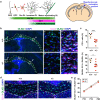Impaired macroglial development and axonal conductivity contributes to the neuropathology of DYRK1A-related intellectual disability syndrome
- PMID: 36402907
- PMCID: PMC9675854
- DOI: 10.1038/s41598-022-24284-5
Impaired macroglial development and axonal conductivity contributes to the neuropathology of DYRK1A-related intellectual disability syndrome
Abstract
The correct development and activity of neurons and glial cells is necessary to establish proper brain connectivity. DYRK1A encodes a protein kinase involved in the neuropathology associated with Down syndrome that influences neurogenesis and the morphological differentiation of neurons. DYRK1A loss-of-function mutations in heterozygosity cause a well-recognizable syndrome of intellectual disability and autism spectrum disorder. In this study, we analysed the developmental trajectories of macroglial cells and the properties of the corpus callosum, the major white matter tract of the brain, in Dyrk1a+/- mice, a mouse model that recapitulates the main neurological features of DYRK1A syndrome. We found that Dyrk1a+/- haploinsufficient mutants present an increase in astrogliogenesis in the neocortex and a delay in the production of cortical oligodendrocyte progenitor cells and their progression along the oligodendroglial lineage. There were fewer myelinated axons in the corpus callosum of Dyrk1a+/- mice, axons that are thinner and with abnormal nodes of Ranvier. Moreover, action potential propagation along myelinated and unmyelinated callosal axons was slower in Dyrk1a+/- mutants. All these alterations are likely to affect neuronal circuit development and alter network synchronicity, influencing higher brain functions. These alterations highlight the relevance of glial cell abnormalities in neurodevelopmental disorders.
© 2022. The Author(s).
Conflict of interest statement
The authors declare no competing interests.
Figures







Similar articles
-
Impaired development of neocortical circuits contributes to the neurological alterations in DYRK1A haploinsufficiency syndrome.Neurobiol Dis. 2019 Jul;127:210-222. doi: 10.1016/j.nbd.2019.02.022. Epub 2019 Mar 1. Neurobiol Dis. 2019. PMID: 30831192 Free PMC article.
-
Dyrk1a Mutations Cause Undergrowth of Cortical Pyramidal Neurons via Dysregulated Growth Factor Signaling.Biol Psychiatry. 2021 Sep 1;90(5):295-306. doi: 10.1016/j.biopsych.2021.01.012. Epub 2021 Apr 8. Biol Psychiatry. 2021. PMID: 33840455 Free PMC article.
-
DYRK1A overexpression enhances STAT activity and astrogliogenesis in a Down syndrome mouse model.EMBO Rep. 2015 Nov;16(11):1548-62. doi: 10.15252/embr.201540374. Epub 2015 Sep 15. EMBO Rep. 2015. PMID: 26373433 Free PMC article.
-
Case report of novel DYRK1A mutations in 2 individuals with syndromic intellectual disability and a review of the literature.BMC Med Genet. 2016 Feb 27;17:15. doi: 10.1186/s12881-016-0276-4. BMC Med Genet. 2016. PMID: 26922654 Free PMC article. Review.
-
[Molecular Mechanism Underlying Abnormal Differentiation of Neural Progenitor Cells in the Developing Down Syndrome Brain].Yakugaku Zasshi. 2017;137(7):795-800. doi: 10.1248/yakushi.16-00236-1. Yakugaku Zasshi. 2017. PMID: 28674289 Review. Japanese.
Cited by
-
Skeletal health in DYRK1A syndrome.Front Neurosci. 2024 Sep 6;18:1462893. doi: 10.3389/fnins.2024.1462893. eCollection 2024. Front Neurosci. 2024. PMID: 39308945 Free PMC article. Review.
-
Analysis of 1386 epileptogenic brain lesions reveals association with DYRK1A and EGFR.Nat Commun. 2024 Nov 30;15(1):10429. doi: 10.1038/s41467-024-54911-w. Nat Commun. 2024. PMID: 39616148 Free PMC article.
-
The role of TSC1 and TSC2 proteins in neuronal axons.Mol Psychiatry. 2024 Apr;29(4):1165-1178. doi: 10.1038/s41380-023-02402-7. Epub 2024 Jan 11. Mol Psychiatry. 2024. PMID: 38212374 Review.
-
Visual and auditory attention in individuals with DYRK1A and SCN2A disruptive variants.Autism Res. 2025 May;18(5):909-921. doi: 10.1002/aur.3202. Epub 2024 Jul 30. Autism Res. 2025. PMID: 39080977 Free PMC article.
-
Lithium normalizes ASD-related neuronal, synaptic, and behavioral phenotypes in DYRK1A-knockin mice.Mol Psychiatry. 2025 Jun;30(6):2584-2596. doi: 10.1038/s41380-024-02865-2. Epub 2024 Dec 5. Mol Psychiatry. 2025. PMID: 39633007 Free PMC article.
References
Publication types
MeSH terms
Substances
Grants and funding
LinkOut - more resources
Full Text Sources
Medical
Molecular Biology Databases

